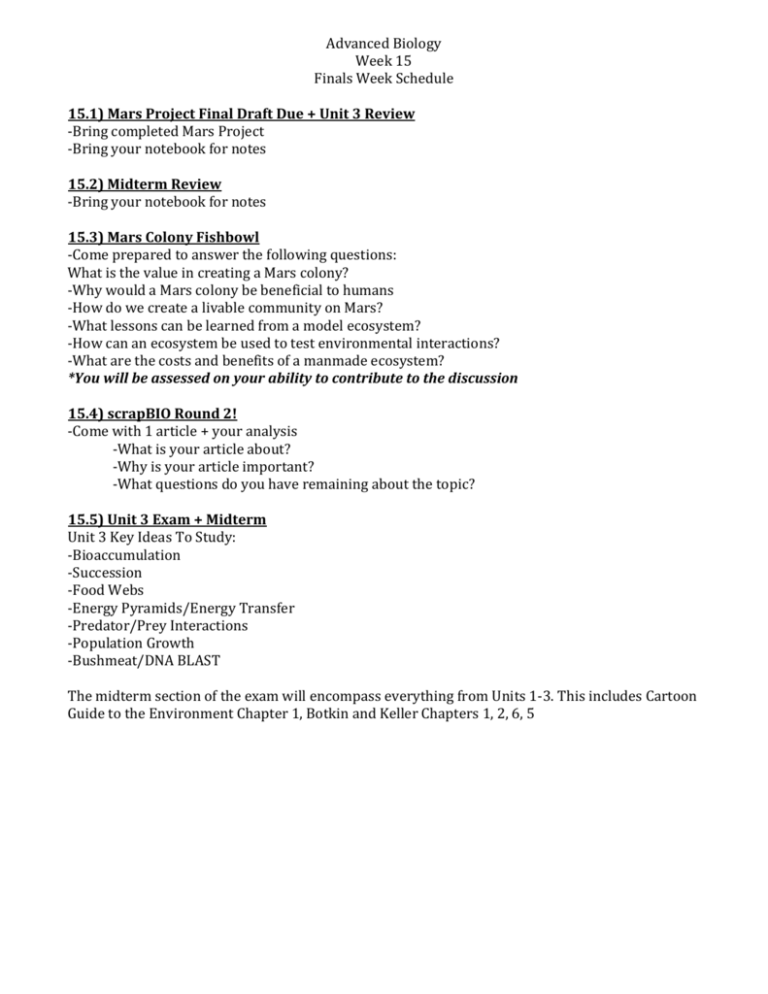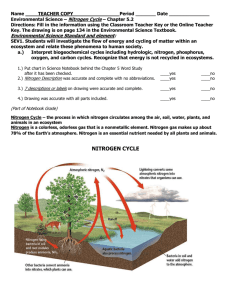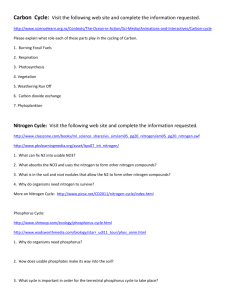Advanced Biology Week 15 Finals Week Schedule 15.1) Mars
advertisement

Advanced Biology Week 15 Finals Week Schedule 15.1) Mars Project Final Draft Due + Unit 3 Review -Bring completed Mars Project -Bring your notebook for notes 15.2) Midterm Review -Bring your notebook for notes 15.3) Mars Colony Fishbowl -Come prepared to answer the following questions: What is the value in creating a Mars colony? -Why would a Mars colony be beneficial to humans -How do we create a livable community on Mars? -What lessons can be learned from a model ecosystem? -How can an ecosystem be used to test environmental interactions? -What are the costs and benefits of a manmade ecosystem? *You will be assessed on your ability to contribute to the discussion 15.4) scrapBIO Round 2! -Come with 1 article + your analysis -What is your article about? -Why is your article important? -What questions do you have remaining about the topic? 15.5) Unit 3 Exam + Midterm Unit 3 Key Ideas To Study: -Bioaccumulation -Succession -Food Webs -Energy Pyramids/Energy Transfer -Predator/Prey Interactions -Population Growth -Bushmeat/DNA BLAST The midterm section of the exam will encompass everything from Units 1-3. This includes Cartoon Guide to the Environment Chapter 1, Botkin and Keller Chapters 1, 2, 6, 5 Botkin and Keller Chapter 1 -World Population is growing exponentially -The greatest population increase has been from 1950-present day Carrying Capacity: The maximum number of individuals that can be supported by an ecosystem -If a population exceeds carrying capacity: famine, war, diseases will decrease population below the carrying capacity -Carrying Capacity of Earth – between 2 and 40 billion people Depends on: -Science: How we are able to use resources -Values: The quality of life; worse conditions=more people Easter Island: Multiple factors led to downfall: Resource exploitation, invasive species, European contact Moral: Limited resources can only support finite population Gaia Hypothesis: Over the history of life on Earth, LIFE has profoundly changed the global environment, and these changes have tended to improve the continuation of life Urbanization: Moving from farms to cities -The world is becoming increasingly urbanized -Tokyo: World’s largest city (13.35 million) Cities are commonly located near rivers and coastlines Destroying Wetlands: Urban sprawl often overtakes good agricultural land and coastal wetlands (important habitats for many endangered species) Precautionary Principle: When there is a threat of serious (or irreversible) environmental damage, we should not wait for scientific proof before taking precautionary steps to prevent potential harm to the environment Utilitarian Justification: The environment directly benefits individuals (ex: lions help tourism) Ecological Justification: The entire ecosystem must survive to protect all species within the ecosystem, so we need to protect all ecosystems Aesthetic Justification: We appreciate nature, so we must protect it Moral Justification: Aspects of the environment have a right to exist, so we must help them Cultural Justification: Different cultures will value different aspects of the environment Botkin and Keller Chapter 2 Mono Lake: Science can tell us one thing, but our values will ultimately determine our decisions Disposability: The essence of science. A statement can be termed “scientific” if it can be disproven -If it cannot be disproven, it is not scientific Observations: The basis of science. Made through the five senses (or with tools that measure what we cannot perceive) Inferences: Generalizations based on our observations -To test an inference, turn it into a hypothesis Hypothesis: A statement that can be disproved Independent Variable (IV): What the scientist is changing (effects the DV). THERE IS ALWAYS ONLY ONE IV Dependent Variable: Changes depending on the IV Standardized Variable: Everything else in your experiment that is kept the same Control Group: An unchanged group (no IV) that you use tyo compare to your experimental group Scientific Theory: A grand scheme that relates and explains many observations and is supported by a great deal of evidence Model: A deliberately simplified construct of nature Alternatives to Direct Experimentation -Historical Evidence: Use of human and ecological records -Modern Catastrophe: Provide ecological experiments Science: The search for understanding of the natural world -Limited by technology available Technology: Application of scientific knowledge in an attempt to benefit people Objectivity: Value-Free science -As scientists, we should ALWAYS try to be objective Pseudoscience: Not testable, based on faulty reasoning or poor methodology Botkin and Keller Chapter 6 Biogeochemical Cycles: Chemicals cycle between atmosphere, hydrosphere, lithosphere, biosphere Chemical Reactions: The process in which new chemicals are formed from elements and compounds through chemical change Limiting Factors: Limits the growth or development of an organism, population, or process Macronutrients: Elements required in large amounts by all life -Big 6: Carbon, Oxygen, Hydrogen, Phosphorus, Nitrogen, Sulfur Micronutrients: Elements required in small amounts by all life, or moderate amounts by some forms of life Geologic Cycle: The processes responsible for formation and change of Earth’s materials -Tectonic: Earth’s outer layer -Hydrologic: Water -Rock: Rocks and Soils -Biochemical: Carbon. Carbon-Silicate, Nitrogen, Phosphorus Carbon Cycle: Carbon is the element that anchor all organic substances -Chemically and biologically linked with the cycles of oxygen and hydrogen that form life Missing Carbon Sink: Substantial amounts of carbon dioxide released into the atmosphere but apparently not reabsorbed and thus remain unaccounted for Mouse in the Jar: Joseph Priestly 1771 said left alone in a sealed jar, a mouse will die… -Unless you add a plant Photosynthesis: Process by which plants and other organisms convert energy, normally from the sun, into chemical energy that can later be released to fuel the organisms’ activities CO2 + H2O -> C6H12O6 + O2 Cellular Respiration: Set of metabolic reactions and processes that take place in the cells of organisms to convert biochemical energy from nutrients into ATP (energy for the cell) C6H12O6 + O2 -> CO2 + H2O + ATP Nitrogen Cycle: Extremely important, nitrogen is required by all living things Nitrogen Fixation: Converting atmospheric nitrogen in the atmosphere to ammonia or nitrate Denitrification: The process of releasing fixed nitrogen to molecular nitrogen Nitrogen in farming: Traditionally, farmers overused the nitrogen in the soil and had to leave fields “fallow” for one season in order to allow the nitrogen to return to the soil Turnip Townshend: If you cycle nitrogen consuming plants with nitrogen-fixing plants, you will not need to leave the fields fallow – nitrogen will be returned to the soil through the plants Nitrogen-fixing plants have special bacteria in their roots that can take nitrogen out of the atmosphere and put it in the soil Phosphorus Cycle: Important because phosphorus is an essential element for life and often is a limiting nutrient for plant growth









